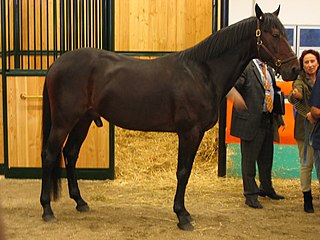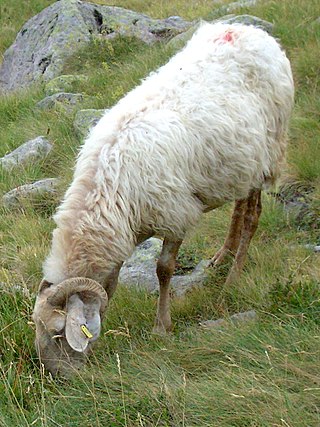Related Research Articles

The Ancona is a breed of chicken which originated in the Marches, region of Italy, but which was bred to its present type mainly in the United Kingdom in the nineteenth century. It is named after the city of Ancona, capital of the Marche. It is popular in Britain and the United States, but uncommon in Italy; an initiative to re-establish it in its native area and preserve its biodiversity was launched in 2000. There are also Ancona bantams.

The Sardinian Anglo-Arab or Anglo-Arabo Sardo is an Italian breed of riding horse from the Mediterranean island of Sardinia. It derives from cross-breeding of local mares with stallions of Arab, Anglo-Arab and Thoroughbred stock. Breeding began in 1874; the breed was officially recognised in 1967.

The Italian Trotter, Italian: Trottatore Italiano, is the Italian breed of trotting horse. It has been selectively bred exclusively for its racing ability. Varenne, one of the most successful trotters in the history of the sport, was an Italian Trotter.
The Sarcidano, Italian: Cavallo del Sarcidano, is a rare Italian breed of semi-feral horse originating from the Altopiano del Sarcidano in the comune of Laconi, in Oristano Province of the Mediterranean island of Sardinia. It is one of the fifteen indigenous horse "breeds of limited distribution" recognised by the AIA, the Italian breeders' association.

The Padovana or Padovana dal gran ciuffo is an ancient Italian breed of small crested and bearded chicken. It originates in, and is named for, the city and surrounding province of Padua, in the Veneto region of north-eastern Italy. Despite continuing discussion surrounding its true origins, it is recognised in Italy as an indigenous Italian breed.

The Martina Franca donkey, Italian: Asino di Martina Franca, is a breed of donkey from Puglia in southern Italy. It is the largest Italian donkey breed, and was famous for its qualities in the production of mules. It is particularly associated with the comune of Martina Franca from which it takes its name, but the area of origin also includes Alberobello, Ceglie Messapica, Locorotondo, Massafra, Mottola and Noci, in the provinces of Bari, Brindisi and Taranto. It is still raised mainly in Puglia, but there are also populations in Abruzzo, Lazio, Lombardy and Umbria. It is one of the eight autochthonous donkey breeds of limited distribution recognised by the Ministero delle Politiche Agricole Alimentari e Forestali, the Italian ministry of agriculture and forestry.

The Brigasca, French: Brigasque, is a breed of sheep from Liguria in north-west Italy and the département of Alpes-Maritimes in south-eastern France. It takes its name from the town of La Brigue, which was until 1947 in the Italian province of Cuneo. The Brigasca is raised in the provinces of Imperia and Savona in Italy, and neighbouring areas in France. It appears to have origins in common with the Frabosana and Delle Langhe breeds. It is one of the forty-two autochthonous local sheep breeds of limited distribution for which a herdbook is kept by the Associazione Nazionale della Pastorizia, the Italian national association of sheep-breeders.
The Ciavenasca is a breed of small domestic sheep from the province of Sondrio, in Lombardy in northern Italy. It is raised in the mountainous terrain of the Val San Giacomo, the Val Bregaglia and the Valchiavenna, from which the name of the breed derives. It is raised only for meat; the wool is of very poor quality, and the milk is sufficient only for the lambs. It is one of the forty-two autochthonous local sheep breeds of limited distribution for which a herdbook is kept by the Associazione Nazionale della Pastorizia, the Italian national association of sheep-breeders.
The Cornella Bianca is a breed of domestic sheep from the Apennines of Emilia–Romagna in central Italy. It is raised principally in mountainous parts of the provinces of Bologna, Modena and Reggio Emilia, where it is transhumant. Some are also raised in the plains around Ferrara, Rovigo and Vicenza. It is found particularly in the comuni of Minerbio, Baricella and Malalbergo in the province of Bologna and Argenta in the province of Ferrara.
The Finarda is a breed of large domestic sheep from the regions of Lombardy and Piemonte in northern Italy. It is heavy breed raised mainly for meat, although it also yields 4–6 kg of wool per year. It results from cross-breeding the Bergamasca and Biellese breeds. It is one of the forty-two autochthonous local sheep breeds of limited distribution for which a herdbook is kept by the Associazione Nazionale della Pastorizia, the Italian national association of sheep-breeders. However, in 2008 the herdbook was empty, and may in fact never have been activated. Most data for the breed dates from 1983.
The Frabosana is a breed of sheep from the valleys of the Monregalese, the area around Mondovì in the province of Cuneo, in Piemonte in north-west Italy. It takes its name from the comuni of Frabosa Soprana and Frabosa Sottana, and was once the most numerous sheep breed of Piemonte. It is raised in the Valle Gesso, the Valle Grana, the Valle Pesio, the Valle Vermenagna and the Valli Monregalesi in the province of Cuneo, and in the Val Pellice in the province of Turin. Two types are recognised within the breed, the Roaschino in the Ligurian Alps, and the slightly smaller Frabosana raised in the area of Mondovì. The Frabosana is one of the forty-two autochthonous local sheep breeds of limited distribution for which a herdbook is kept by the Associazione Nazionale della Pastorizia, the Italian national association of sheep-breeders.
The Garessina or Muma is a breed of small sheep from the Garessina, the area surrounding Garessio in the province of Cuneo, in Piemonte in north-west Italy. It is raised principally in the valleys of the Tanaro, its affluent the Negrone, and the Casotto; it is not raised commercially, but kept as a family sheep. It has been influenced by Spanish Merino and French Alpine breeds. The wool is of fine quality. The Garessina is one of the forty-two autochthonous local sheep breeds of limited distribution for which a herdbook is kept by the Associazione Nazionale della Pastorizia, the Italian national association of sheep-breeders.
The Garfagnina Bianca is a breed of small domestic sheep from the historic area of the Garfagnana, the mountainous northern part of the province of Lucca, in Tuscany in central Italy. It shares common origins with the Cornella Bianca, Massese and Zerasca. It is one of the forty-two autochthonous local sheep breeds of limited distribution for which a herdbook is kept by the Associazione Nazionale della Pastorizia, the Italian national association of sheep-breeders.
The Lamon or Lamonese is a breed of sheep from the comuni of Lamon and Sovramonte in the province of Belluno, in the Veneto in north-east Italy. The area is known as the Feltrino, from the town of Feltre, and the breed may also be referred to as the Feltrina. It was formerly widely distributed in the Veneto and the Trentino, and as far as the province of Mantova in Lombardy. In the 1950s there was an attempt to increase the size by cross-breeding with the Bergamasca; there was also some cross-breeding with the Padovana and the now extinct Trentina. The Lamon is one of the forty-two autochthonous local sheep breeds of limited distribution for which a herdbook is kept by the Associazione Nazionale della Pastorizia, the Italian national association of sheep-breeders.
The Nostrana is a breed of sheep from the area of the Passo della Cisa, the Apennine pass which connects the comune of Pontremoli in the province of Massa Carrara, Tuscany, with that of Berceto in the province of Parma, in Emilia–Romagna. The Nostrana appears to be closely related to the Garfagnina Bianca, and probably also to the Cornigliese and Zerasca breeds. It is one of the forty-two autochthonous local sheep breeds of limited distribution for which a herdbook is kept by the Associazione Nazionale della Pastorizia, the Italian national association of sheep-breeders.
The Pomarancina is a breed of domestic sheep from Tuscany in central Italy. It is raised mainly in the comune of Pomarance, from which it takes its name, and in the neighbouring comuni of Castelnuovo di Val di Cecina, Montecatini Val di Cecina and Volterra, all in the province of Pisa; some are kept in other parts of Tuscany, in the provinces of Grosseto, Livorno, Lucca and Siena. It is one of the forty-two autochthonous local sheep breeds of limited distribution for which a herdbook is kept by the Associazione Nazionale della Pastorizia, the Italian national association of sheep-breeders.

The Rosset is a breed of domestic sheep from the Valle d'Aosta in north-west Italy. It is morphologically similar to the Savoiarda breed from Piemonte and to the Thônes et Marthod breed from Savoie; it may have been influenced also by the Blanc des Alpes and the Biellese. It is one of the forty-two autochthonous local sheep breeds of limited distribution for which a herdbook is kept by the Associazione Nazionale della Pastorizia, the Italian national association of sheep-breeders.

The Sarda or Suino Sardo is a breed of domestic pig from the Mediterranean island of Sardinia, Italy. It is raised mainly in the provinces of Ogliastra and Nuoro, but is also present in those of Medio Campidano and Sassari and in the Sarrabus-Gerrei sub-region. The Sarda breed was officially recognised by ministerial decree on 8 June 2006 and became the sixth autochthonous pig breed recognised by the Ministero delle Politiche Agricole Alimentari e Forestali, the Italian ministry of agriculture and forestry.

The Chamois Coloured Goat, French: Chèvre chamoisée, German: Gämsfarbige Gebirgsziege, Italian: Camosciata delle Alpi, is an indigenous breed of domestic goat from Switzerland. It is distributed throughout Switzerland and in parts of northern Italy and Austria, and has been exported to other countries including France. There are two strains, a horned type from the Grisons or Graubünden in the eastern part of the country, and a hornless type from the former bezirk of Oberhasli and the area of Brienz and Lake Brienz in the Bernese Oberland in central Switzerland. In some countries the hornless variety may be considered a separate breed, the Oberhasli goat. The Swiss herd-book was established in 1930.
References
- ↑ Atlante delle razze di cavalli (in Italian). agraria.org. Accessed September 2013.
- ↑ Breed data sheet: Italy, Horse. Domestic Animal Diversity Information System of the Food and Agriculture Organization of the United Nations. Accessed September 2013.
- 1 2 Daniele Bigi, Alessio Zanon (2008). Atlante delle razze autoctone: Bovini, equini, ovicaprini, suini allevati in Italia (in Italian). Milan: Edagricole. ISBN 9788850652594.
- ↑ Lipizzano (in Italian). Roma: Associazione Italiana Allevatori, Ufficio Centrale del Libro Genealogico. Accessed May 2022